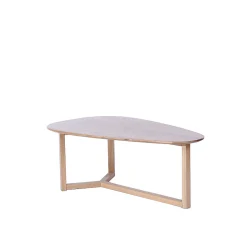Types of Mango Wood Furniture
2024-05-31
Mango wood furniture has gained popularity in recent years due to its sustainability, durability, and unique aesthetic qualities. Here’s a detailed overview of mango wood furniture:
Characteristics of Mango Wood
1. Durability: Mango wood is a dense and robust hardwood, making it durable and long-lasting. It is resistant to wear and tear, making it suitable for furniture that sees frequent use.
2. Aesthetic Appeal: Mango wood has a distinct grain pattern and varying shades of color, ranging from light to dark tones. This natural variation gives each piece of furniture a unique and attractive appearance.
3. Workability: The wood is relatively easy to work with, allowing for intricate designs and carvings. It also takes well to stains and finishes, enhancing its natural beauty.
4. Sustainability: Mango trees are primarily grown for their fruit. Once the trees reach the end of their fruit-bearing life, they are harvested for wood, making mango wood a sustainable and eco-friendly option.
Types of Mango Wood Furniture
1. Tables: Dining tables, coffee tables, and side tables made from mango wood are popular due to the wood’s durability and attractive grain patterns.
2. Chairs and Benches: Mango wood is used to craft sturdy and stylish chairs and benches, often featuring intricate carvings or minimalist designs.
3. Cabinets and Shelves: The strength of mango wood makes it ideal for cabinets, bookshelves, and other storage furniture.
4. Beds and Headboards: Mango wood beds and headboards offer a solid and aesthetic choice for bedroom furniture.
5. Accent Pieces: Smaller items like stools, side tables, and decorative pieces are also commonly made from mango wood.
Advantages of Mango Wood Furniture
1. Sustainability: As a byproduct of the mango fruit industry, using mango wood helps reduce waste and promotes sustainable forestry practices.
2. Unique Aesthetic: The wood’s natural variations in color and grain make each piece of furniture unique.
3. Affordability: Compared to other hardwoods like oak or teak, mango wood is relatively affordable.
4. Durability: Its hardness and resistance to water make it suitable for various furniture pieces.
Care and Maintenance
1. Cleaning: Regular dusting and cleaning with a soft, damp cloth are usually sufficient. Avoid using harsh chemicals or abrasive cleaners.
2. Polishing: Periodic polishing with a suitable wood polish can help maintain the wood’s luster and protect the surface.
3. Protection: Use coasters, placemats, and tablecloths to protect the furniture from heat, spills, and scratches.
4. Humidity Control: Keep the furniture in a stable environment with moderate humidity to prevent warping or cracking.
Environmental Impact
- Eco-Friendly Choice: Mango wood is considered an environmentally friendly option because it repurposes trees that are no longer productive for fruit.
- Reduced Deforestation: By using mango wood, the demand for other hardwoods can be reduced, helping to mitigate deforestation.
Popularity and Trends
- Rustic and Vintage Styles: Mango wood furniture is often featured in rustic, vintage, and bohemian interior designs due to its natural and earthy look.
- Modern Designs: Contemporary furniture designers also use mango wood for sleek, modern pieces, showcasing the wood’s versatility.
Challenges
1. Moisture Sensitivity: Although resistant to water, excessive exposure to moisture can still cause damage over time.
2. Availability: Depending on the region, mango wood furniture might not be as readily available as other types of wood furniture.
Mango wood furniture combines sustainability with beauty and durability, making it a desirable choice for a wide range of interior design styles. Its unique aesthetic and environmental benefits contribute to its growing popularity in the furniture market.



